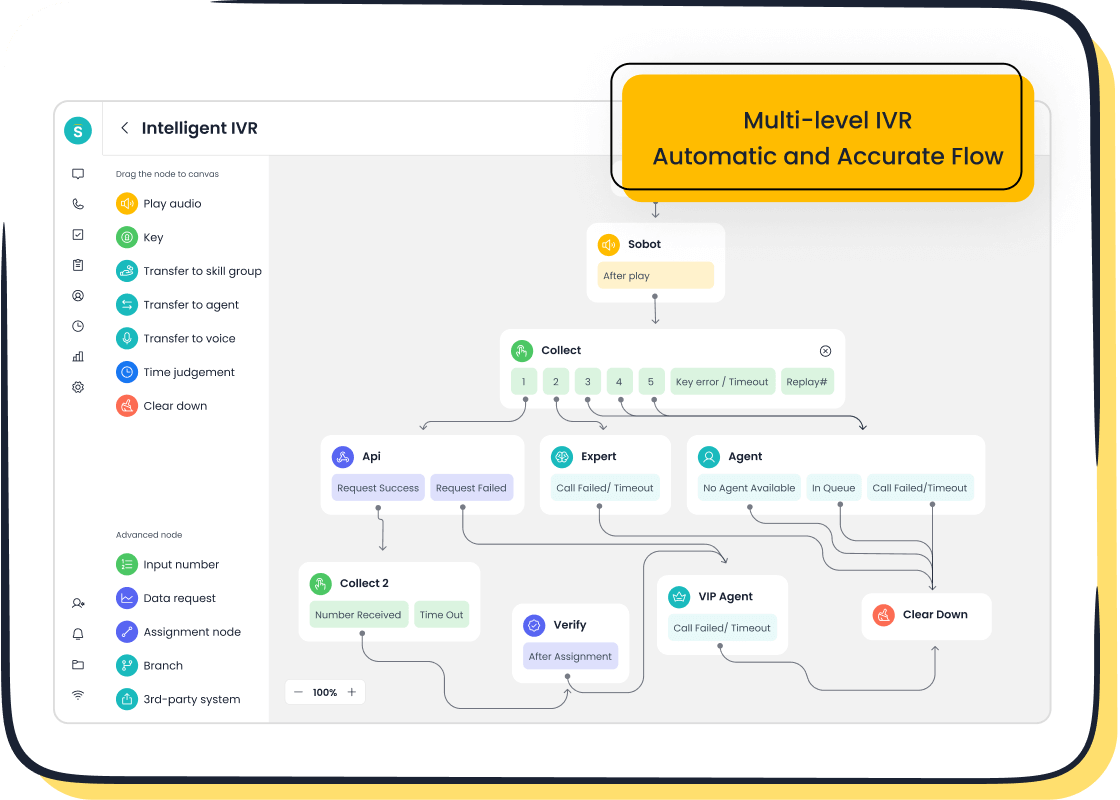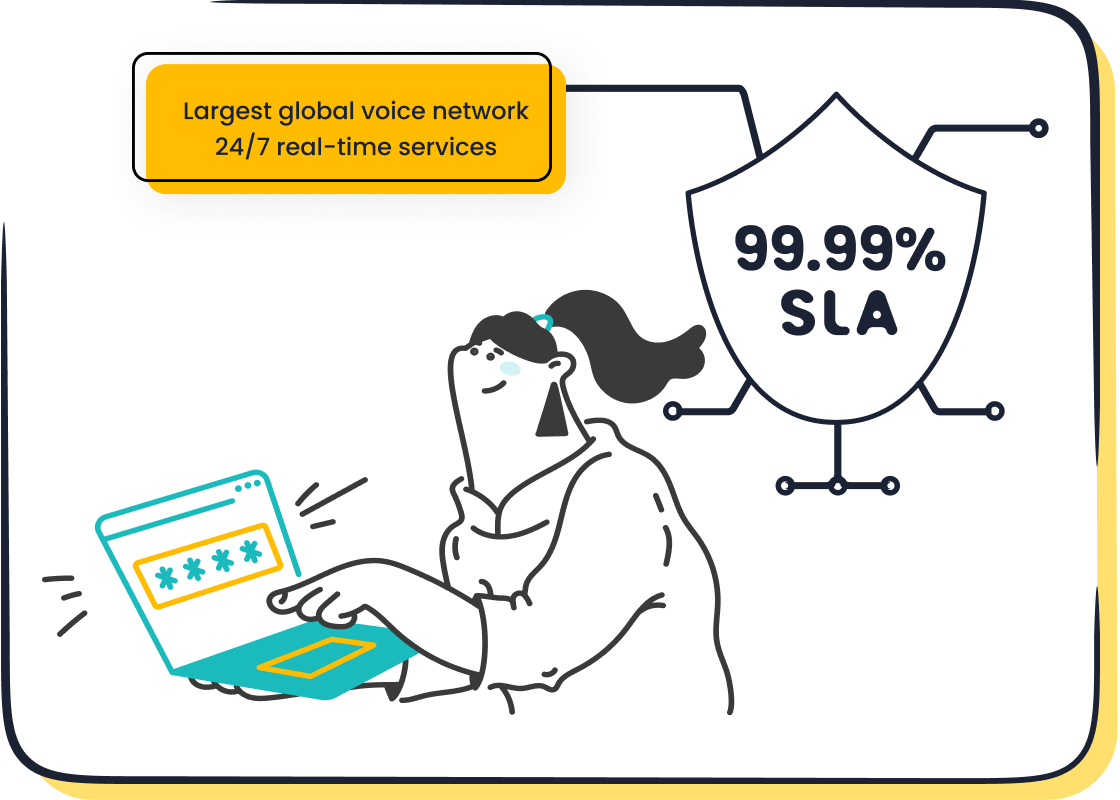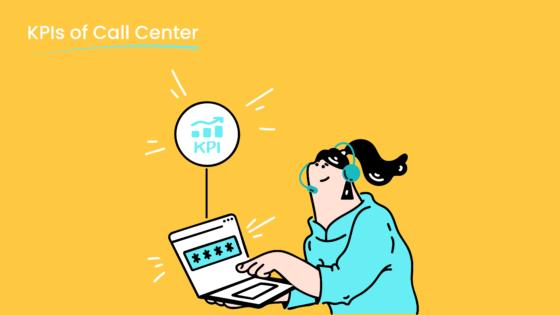How to Set Up an Interactive Voice Response System

Interactive voice response (IVR) is an automated telecommunication technology that interacts with callers using voice or touch-tone input. It acts as a virtual receptionist, guiding users through pre-recorded menus to resolve inquiries or route calls to the right department. By automating routine tasks, IVR enhances customer service efficiency and reduces operational costs. For instance, improving IVR containment rates by just 5% can cut call center expenses by up to 30%.
Many businesses rely on IVR to handle multiple calls simultaneously, ensuring faster resolutions and better customer experiences. Sobot’s Voice/Call Center offers a robust platform to build and customize IVR systems. With features like intelligent call routing and AI-powered voicebots, it helps businesses streamline operations while delivering personalized service.
Step-by-Step Guide to Setting Up an IVR System
Select a Phone Number and Service Provider
Choose between toll-free, local, or international numbers.

Choosing the right phone number is a critical first step in your IVR setup. Toll-free numbers are ideal for businesses aiming to attract a national audience, as they eliminate call charges for customers. Local numbers, on the other hand, create a sense of familiarity and trust within specific regions. If your business operates globally, international numbers ensure accessibility for customers worldwide. Sobot’s Voice/Call Center offers global number availability, making it easier to connect with your audience no matter where they are.
Evaluate service providers with IVR capabilities, including Sobot's Voice/Call Center.
Selecting a reliable service provider ensures your IVR system operates smoothly. Use the following table to evaluate providers:
| Criteria | Description |
|---|---|
| Ease of use | The system should be intuitive and user-friendly for both customers and agents. |
| Customer support | Availability of support, including 24/7 assistance and quick response times. |
| User experience | The overall satisfaction of users with the system's design and functionality. |
| Pricing | Evaluation of monthly costs, including any additional fees or discounts. |
| General features | Standard IVR features like call routing and voicemail. |
| Advanced features | More complex functionalities such as customizable menus and call management. |
| Integration & compatibility | How well the IVR system works with existing business tools and technologies. |
| Security & compliance | Adherence to data protection regulations and cybersecurity measures. |
| User scores | Analysis of user reviews and ratings from various platforms. |
Sobot’s Voice/Call Center excels in these areas, offering intelligent IVR, seamless integrations, and a 99.99% uptime guarantee.
Set Up Your Menu and Call Flow
Map out the customer journey and menu options.
To build IVR menus effectively, start by mapping the customer journey. Identify common inquiries and create logical paths to address them. For example, a retail business might include options for order tracking, returns, and live agent support. Use intelligent call routing to connect customers to the right department quickly. Sobot’s drag-and-drop interface simplifies this process, allowing you to design and launch your IVR system in real time.
Use clear, concise language for menu prompts.
Clarity is key when designing IVR menus. Avoid jargon and keep instructions simple. For instance, instead of saying, “Press one to inquire about your recent transaction,” use “Press one for order updates.” This approach minimizes confusion and enhances user experience. Regularly update your IVR menu to reflect current services and test it to ensure functionality.
Record or Generate Professional Voice Prompts
Use professional voice talent or AI-powered tools like Sobot's Voice/Call Center.
Professional voice prompts establish credibility and enhance customer trust. You can hire voice talent to capture your brand’s tone or use AI-powered tools for scalability and cost-effectiveness. Sobot’s Voice/Call Center offers AI-powered voicebots that deliver clear, natural-sounding prompts, ensuring a seamless experience for your callers.
Ensure prompts are culturally appropriate and easy to understand.
Cultural considerations play a significant role in IVR effectiveness. Tailor your prompts to reflect local dialects and norms. For instance, a business serving a bilingual audience might offer menu options in multiple languages. This approach not only improves customer satisfaction but also fosters loyalty by showing respect for cultural diversity.
Configure Call Routing and System Integrations
Set up smart call routing to agents or departments.
Smart call routing ensures your IVR system connects callers to the right agents or departments efficiently. Start by analyzing customer interactions using CRM data and call logs. This helps you map out customer journeys and identify common call types. Next, group agents based on their skills and expertise. For example, route technical queries to IT specialists and billing questions to the finance team. Then, create routing rules that match customer needs with the most suitable agents.

Sobot’s Voice/Call Center simplifies this process with its intelligent IVR and smart call routing features. It allows you to configure workflows easily and ensures calls are directed based on agent availability, skills, or customer preferences. Monitoring call distribution and agent performance helps you refine routing rules over time, ensuring continuous improvement.
Integrate the IVR system with CRM or ticketing systems, such as Sobot's unified workspace.
Integrating your IVR system with CRM or ticketing tools enhances efficiency and customer satisfaction. This integration ensures seamless data synchronization, keeping customer information accurate and up-to-date. For instance, when a caller enters their account number, the system can display their details to the agent, reducing call handling time.

Sobot’s unified workspace takes this a step further by consolidating customer data, call logs, and tickets into one platform. This integration personalizes the caller experience by greeting them by name and offering relevant options. It also eliminates manual data entry, improving call quality and boosting customer loyalty. With Sobot’s open API, you can easily connect your IVR system to existing tools, ensuring smooth operations.
Test and Launch Your IVR System
Conduct thorough testing for functionality and user experience.
Testing is crucial to ensure your IVR system works as intended. Begin with functional testing to validate menus, prompts, and call flows. Integration testing checks compatibility with devices and audio tools. Usability testing evaluates accessibility for diverse users, while audio-quality testing ensures prompts sound clear and professional. Finally, performance testing monitors how the system handles different conditions, such as high call volumes.

For example, a retail business might simulate peak shopping hours to test system performance. Sobot’s Voice/Call Center supports real-time monitoring, allowing you to identify and resolve issues quickly. Comprehensive testing ensures your IVR system delivers a seamless experience for all users.
Monitor performance and gather feedback post-launch.
After launching your IVR system, monitoring its performance helps you identify areas for improvement. Use metrics like customer satisfaction scores (CSAT), call abandonment rates, and first call resolution rates to evaluate effectiveness. For instance, aim for a call abandonment rate under 5% and a first call resolution rate above 70%.
Gathering feedback directly from customers provides valuable insights. A healthcare company, for example, used an IVR system to conduct post-visit surveys. Patients responded using touch-tone selections, enabling the company to analyze feedback and improve services. Sobot’s analytics tools make it easy to track performance and refine your IVR system over time, ensuring it continues to meet customer needs.
Tools and Software to Customize Your IVR System
IVR Platforms and Providers
Examples of IVR platforms, including Sobot's Voice/Call Center.
Choosing the right platform is essential to build an effective IVR system. Here’s a comparison of popular IVR platforms and their standout features:
| IVR Platform | Distinguishing Features |
|---|---|
| AirCall | Customizable call flows, real-time reporting, CRM integration, intuitive interface. |
| Nextiva | Automated call routing, detailed reporting, scalability, and reliability. |
| TalkDesk | Flexible call routing, analytics, and seamless system integration. |
| RingCentral | Complex call flows, real-time data access, and CRM integration. |
| Twilio | Advanced call routing, customizable call flows, and real-time insights. |
Sobot’s Voice/Call Center stands out with its intelligent IVR, drag-and-drop menu builder, and global number availability. Its 99.99% uptime ensures reliability, while seamless integration with CRM systems enhances efficiency.
Key features to look for in an IVR provider.
When selecting an IVR provider, prioritize features that align with your business needs. Look for:
- Self-service options to handle basic inquiries.
- Omnichannel routing for seamless communication across channels.
- Customization options to adapt to changing call volumes.
- Scheduled callbacks to reduce wait times.
- Advanced voice recognition for smoother navigation.
- Easy setup for a hassle-free transition.
- Integration with third-party tools for streamlined operations.
- 24/7 support to address issues anytime.
- Fast and accurate routing to connect callers to the right agent.
Sobot’s Voice/Call Center offers all these features, making it a reliable choice for businesses aiming to customize their IVR system effectively.
CRM and Call Center Software Integration
Importance of integrating IVR with customer management tools.
Integrating your IVR system with CRM software enhances customer service by providing agents with real-time access to customer data. This integration improves efficiency and personalizes interactions. Here’s how:
| Benefit | Description |
|---|---|
| Enhanced Customer Experience | Personalizes interactions by anticipating customer needs. |
| Increased Agent Productivity | Equips agents with relevant information for faster resolutions. |
| Real-time Access to Data | Provides up-to-date customer details during calls for better decision-making. |

Sobot’s unified workspace consolidates customer data, call logs, and tickets into one platform. This integration reduces manual tasks and ensures a seamless experience for both agents and customers.
Voice Prompt Tools
Options for recording or generating voice prompts.
You can create professional voice prompts using traditional voice talent or AI-powered tools. AI tools like Sobot’s Voice/Call Center offer faster production and greater flexibility. They allow you to generate prompts instantly, saving time and resources.
Benefits of using AI-powered text-to-speech tools.
AI-powered tools provide several advantages:
- Offer diverse voice options, including different genders, ages, and accents.
- Replicate various accents for clear communication in multicultural markets.
- Enable quick adjustments to prompts, ensuring efficiency.
- Understand a wide range of voice commands, leading to faster resolutions.

Sobot’s AI-powered voicebots deliver natural-sounding prompts, enhancing the caller experience and improving satisfaction.
Best Practices for Creating an Effective IVR System
Keep Menus Simple and Intuitive
Limit the number of menu options to avoid overwhelming callers.
A cluttered IVR menu can confuse and frustrate callers. To keep things simple, limit the main menu to five to seven options. This range ensures clarity without overwhelming users. Place the most frequently requested services at the beginning of the menu. For example, a retail business might prioritize options like order tracking or returns. Additionally, reduce the main menu duration to 30 seconds or less to maintain caller engagement.
Avoid asking customers to repeat information they’ve already provided. Enable features like barge-in, allowing callers to make selections anytime during the prompt. Sobot’s IVR system supports these functionalities, ensuring a smooth and efficient experience for your customers.
Use logical and predictable menu structures.
Designing a logical menu structure helps callers navigate your IVR system effortlessly. Map out the call flow to ensure a natural progression of options. For instance, group related services under a single category, such as billing or technical support. Use clear and concise prompts to guide users effectively. Offering both voice and dialpad responses adds flexibility, catering to diverse preferences.
Sobot’s drag-and-drop IVR builder simplifies this process, letting you create intuitive menus that align with customer needs.
Offer a Live Agent Option
Provide an easy way for callers to reach a human representative.
Not all issues can be resolved through automation. Offering a live agent option ensures callers can address complex concerns effectively. This approach fosters trust and builds stronger customer relationships. Highlight this option early in the IVR menu to reduce frustration. For example, after listing a few automated services, include a prompt like, “Press zero to speak with a representative.”
Sobot’s IVR system allows you to route calls to agents seamlessly, ensuring personalized service for more nuanced inquiries.
Highlight the live agent option early in the menu.
Positioning the live agent option prominently in your IVR menu enhances accessibility. Limit the number of IVR options to streamline navigation and direct callers to agents quickly. For instance, a healthcare provider might offer automated appointment scheduling but prioritize live agent support for urgent medical queries.
Sobot’s smart call routing ensures callers connect with the right agent based on their needs, improving satisfaction and resolution rates.
Regularly Update and Optimize the System
Review call data to identify areas for improvement.
Analyzing call data helps you refine your IVR system over time. Metrics like call abandonment rates and average handling times reveal pain points in the customer journey. For example, a high abandonment rate might indicate overly complex menus. Use this data to adjust call flows and improve efficiency.
Sobot’s real-time analytics tools make it easy to monitor performance and identify areas for optimization.
Update prompts and routing based on customer feedback.
Customer feedback is invaluable for enhancing your IVR system. Conduct surveys or review voice recordings to gather insights. Use this information to update prompts, refine routing rules, and address common complaints. For instance, if customers frequently request a specific service, consider adding it to the main menu.
Sobot’s IVR system supports continuous updates, ensuring your menu stays relevant and user-friendly.
Common Challenges and How to Overcome Them
Improving Speech Recognition Accuracy
Use high-quality microphones and noise-canceling technology.
Speech recognition in an IVR system often struggles with background noise and unclear audio. Using high-quality microphones and noise-canceling technology can significantly improve accuracy. For example, a retail business handling customer inquiries through an automated phone system can reduce errors by ensuring clear audio input. This approach minimizes misinterpretation of customer responses, leading to smoother interactions.
Train the system with diverse voice samples.
Training your IVR system with diverse voice samples ensures it recognizes various accents and speech patterns. For instance, a global business might collect voice data from different regions to enhance recognition accuracy. Additionally, offering alternative input methods, such as keypad entry, provides a backup for users facing difficulties. Clear instructions, like “Press 1 for billing,” can further reduce errors and improve user satisfaction.
| Challenge | Description |
|---|---|
| Voice Recognition Limitations | Background noise and accents can hinder voice recognition technologies. |
| Database Inconsistencies | Inaccurate or outdated information in the system can lead to wrong responses. |
Reducing Caller Frustration
Avoid long wait times and repetitive prompts.
Long wait times frustrate callers and increase abandonment rates. Implementing features like callback options can help. For example, Sobot’s IVR system allows customers to request a callback, reducing wait times and improving satisfaction. Avoid repetitive prompts by ensuring the system remembers previously entered information, such as account numbers.
Provide clear instructions and progress updates.
Clear instructions guide callers through the IVR system efficiently. For instance, instead of saying, “Please hold,” use, “Your estimated wait time is two minutes.” Providing updates during hold times, such as queue position or expected wait time, keeps callers informed. Adding relaxing music or helpful tips during the wait can also enhance the experience.
| Strategy | Description |
|---|---|
| Immediate Representative Option | Allow callers to speak to a representative right away to enhance their experience. |
| Callback Option | Offer a callback feature to minimize wait times for customers. |
| Pleasant Wait Times | Use relaxing music and provide updates during hold times. |
Simplifying Navigation
Use fewer menu layers to reduce complexity.
Simplifying your IVR system’s menu structure improves customer satisfaction. Limit the number of options in each menu layer to avoid overwhelming callers. For example, a healthcare provider might group all appointment-related services under one option. Shorter menus also reduce wait times, making the system more efficient.
Test the system with real users to identify pain points.
Testing your IVR system with real users helps identify areas for improvement. For instance, a business might discover that customers struggle to find specific options. Regularly reviewing and decluttering menu options ensures a streamlined experience. Sobot’s drag-and-drop IVR builder makes it easy to adjust menus based on user feedback.
- Simplifying IVR menus leads to improved customer satisfaction by reducing frustration.
- Shortening menu length helps in decreasing wait times for customers.
- Providing clear exit options enhances self-service capabilities and gives customers a sense of control.
Optimizing Your IVR System for Business Success
Personalize the Caller Experience
Use caller data to provide tailored options.
Personalizing your IVR enhances customer satisfaction and operational efficiency. Use caller data to offer tailored options, such as account-specific services or recent transaction details. For example, a utility company can allow customers to check their bill status or make payments without speaking to an agent. Self-service options like these empower callers and reduce agent workload. Integrating your IVR with a CRM system ensures real-time data retrieval, enabling you to anticipate customer needs and provide relevant solutions.
Greet repeat callers by name or account information.
A personalized greeting creates a welcoming experience. Address repeat callers by their name or account details to build rapport and trust. For instance, a retail business might greet a returning customer with, “Hello, John! Press 1 to track your recent order.” This approach not only saves time but also demonstrates that you value their loyalty. Sobot’s IVR system integrates seamlessly with CRM tools, making it easy to implement personalized greetings and streamline interactions.
Monitor and Analyze Performance
Track key metrics like call abandonment rates and resolution times.
Monitoring performance metrics helps you identify areas for improvement. Focus on key indicators such as:
- Call Abandonment Rate: Aim for less than 5% to ensure callers stay engaged.
- First Call Resolution Rate: Target above 70% to resolve issues efficiently.
- Customer Effort Score: Measure how easily callers navigate your IVR system.
These metrics provide actionable insights into customer satisfaction and system efficiency. For example, a high abandonment rate might indicate overly complex menus or long wait times.
Use analytics to refine the IVR system over time.
Analytics tools help you optimize your IVR system by identifying pain points and improving call flows. For instance, analyzing drop-off points can reveal confusing prompts, allowing you to adjust menus for better navigation. Streamlining menus based on past interactions enhances customer satisfaction and operational efficiency. Sobot’s Voice/Call Center offers real-time analytics, enabling you to refine your IVR system continuously and meet evolving customer needs.
Leverage Sobot's Voice/Call Center for Optimization
Utilize features like smart call routing and AI-powered voicebots.

Sobot’s Voice/Call Center provides advanced tools to optimize your IVR system. Smart call routing ensures callers connect with the right agent or department based on their needs. AI-powered voicebots handle routine inquiries, freeing up agents for more complex tasks. For example, a healthcare provider can use voicebots to schedule appointments while routing urgent calls to live agents. These features improve efficiency and enhance the caller experience.
Benefit from real-time monitoring and analysis.
Real-time monitoring allows you to track system performance and address issues promptly. Sobot’s analytics tools provide insights into call volumes, wait times, and customer satisfaction. For instance, you can identify peak call hours and adjust staffing levels accordingly. This proactive approach ensures your IVR system operates smoothly, delivering consistent service quality.
Setting up an effective ivr system involves several key steps. Start by selecting the right phone number and service provider, then design a clear menu and call flow. Use professional voice prompts and configure smart call routing to enhance efficiency. Testing and optimization are crucial for success. Assemble a dedicated team, create test cases based on real interactions, and validate the system through functional, usability, and performance testing. Regular updates based on customer feedback ensure your ivr system stays relevant and user-friendly.
Customer feedback plays a vital role in improving your ivr. It enhances the customer experience, increases engagement, and provides accurate data for optimization. Automating feedback collection saves time and reduces costs, while scalability ensures the system can handle high response volumes. Sobot's Voice/Call Center offers tools like real-time analytics and AI-powered voicebots to help you refine your ivr system and achieve business success. Explore its features to create a seamless and personalized caller experience.
FAQ
What is an IVR system, and how does it work?
An IVR system is an automated telecommunication tool that interacts with callers through voice or keypad inputs. It guides users via pre-recorded menus to resolve inquiries or route calls. For example, pressing "1" might connect you to customer support, while "2" provides account details.
How can an IVR system improve customer service?
An IVR system enhances customer service by automating routine tasks, reducing wait times, and routing calls efficiently. For instance, Sobot’s intelligent IVR ensures callers reach the right department quickly, improving satisfaction and operational efficiency.
Can I customize my IVR system for my business needs?
Yes, you can customize your IVR system to match your business requirements. Sobot’s drag-and-drop IVR builder allows you to create personalized menus, greetings, and call flows in real time, ensuring a tailored experience for your customers.
How do I ensure my IVR system is user-friendly?
To make your IVR system user-friendly, keep menus simple and intuitive. Use clear prompts and limit menu options to avoid overwhelming callers. Regular testing and updates based on customer feedback also help improve usability.
What tools can I use to monitor my IVR system’s performance?
You can use analytics tools to track metrics like call abandonment rates and resolution times. Sobot’s Voice/Call Center offers real-time monitoring and analysis, helping you refine your IVR system for better performance and customer satisfaction.
See Also
Step-by-Step Instructions for Setting Up IVR Software
Key Features of Interactive Voice Response Systems
Comparative Analysis of Leading IVR Software Solutions